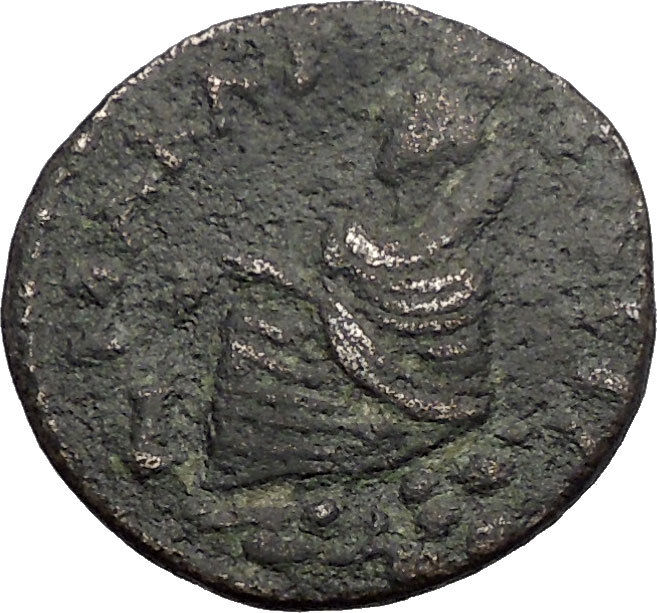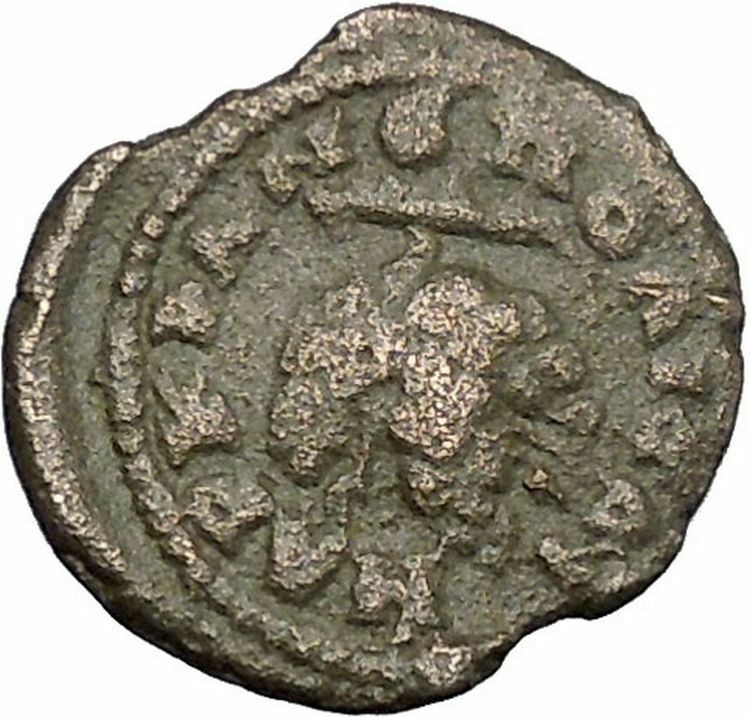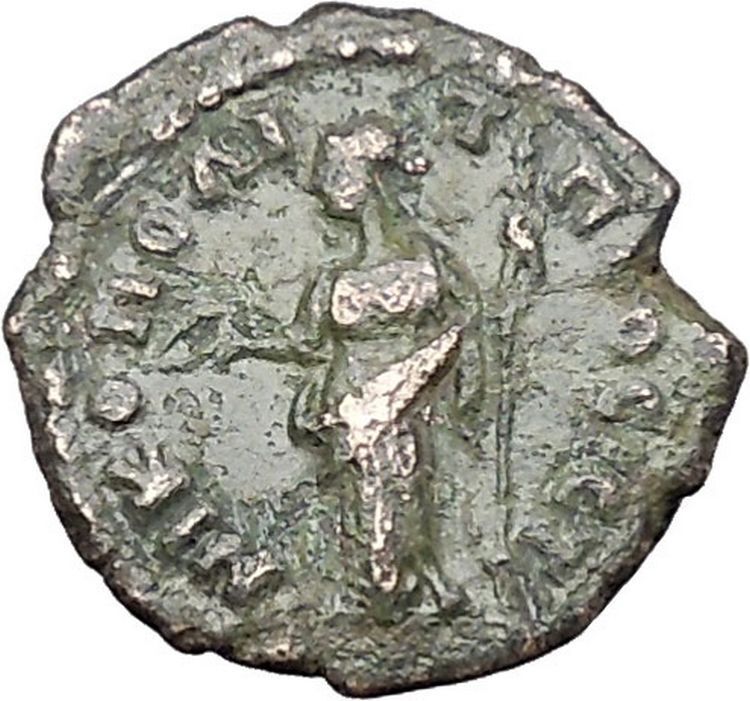|
Tiberius – Roman Emperor: 14-37 A.D.
Bronze 29mm (12.25 grams) of Calagurris in Spain
C. Celer and C. Rectus IIviri (Duumviri)
Reference: Sear GIC 238; RPC I 450; Heiss 167, 29; Cohen 200, 117
TI. CAESAR DIVI AVG. F. AVGVSTVS., Laureate head right.
C. CELERE C. RECTO II. VIR M.C.I., Bull standing right.
You are bidding on the exact item pictured, provided with a Certificate of Authenticity and Lifetime Guarantee of Authenticity.
Tiberius – Roman Emperor: 14-37 A.D.
| Son of Livia | Step-son, son-in-law and heir of Augustus | Husband of Vipsania Agrippina and Julia | Brother of Nero Claudius Drusus | Father of Drusus (by Vipsania Agrippina) | Son-in-law of Agrippa | Father-in-law of Livilla | Grandfather of Livia Julia, and (possibly) of Tiberius Gemellus and Germanicus Gemellus | Uncle and Adoptive father of Germanicus, Claudius and Livilla | Adoptive grandfather of Nero Caesar, Drusus Caesar, Caligula, Agrippina Junior, Drusilla and Julia Livilla |
Tiberius Julius Caesar Augustus, born Tiberius Claudius Nero (November 16, 42 BC – March 16, AD 37), was the second Roman Emperor, from the death of Augustus in AD 14 until his own death in 37. Tiberius was by birth a Claudian, son of Tiberius Claudius Nero and Livia Drusilla. His mother divorced his father and was remarried to Octavian Augustus in 39 BC, making him a step-son of Octavian. Tiberius would later marry Augustus’ daughter Julia the Elder (from an earlier marriage) and even later be adopted by Augustus, by which act he officially became a Julian, bearing the name Tiberius Julius Caesar. The subsequent emperors after Tiberius would continue this blended dynasty of both families for the next forty years; historians have named it the Julio-Claudian dynasty.
Tiberius was one of Rome’s greatest generals, whose campaigns in Pannonia, Illyricum, Rhaetia and Germania laid the foundations for the northern frontier. But he came to be remembered as a dark, reclusive, and somber ruler who never really desired to be emperor; Pliny the Elder called him tristissimus hominum, “the gloomiest of men.” After the death of Tiberius’ son Drusus Julius Caesar in 23, the quality of his rule declined and ended in a terror. In 26, Tiberius exiled himself from Rome and left administration largely in the hands of his unscrupulous Praetorian Prefects Lucius Aelius Sejanus and Quintus Naevius Sutorius Macro. Caligula, Tiberius’ adopted grandson, succeeded the Emperor upon his death.
Background
Tiberius Nero was born on November 16, 42 BC to Tiberius Nero and Livia Drusilla, in Rome. In 39 BC, his mother divorced his biological father and remarried Gaius Julius Caesar Octavianus shortly thereafter, while still pregnant with Tiberius Nero’s son. Shortly thereafter in 38 BC his brother, Nero Claudius Drusus, was born. Little is recorded of Tiberius’s early life. In 32 BC, Tiberius made his first public appearance at the age of nine, delivering the eulogy for his biological father. In 29 BC, both he and his brother Drusus rode in the triumphal chariot along with their adoptive father Octavian in celebration of the defeat of Antony and Cleopatra at Actium. In 26 BC, Augustus became gravely ill, and his possible death threatened to plunge the Roman world into chaos again. Historians generally agree that it is during this time that the question of Augustus’s heir became most acute, and while Augustus had seemed to indicate that Agrippa and Marcellus would carry on his position in the event of his death, the ambiguity of succession became Augustus’s chief problem.
In response, a series of potential heirs seem to have been selected, among them Tiberius and his brother, Drusus. In 24 BC, at the age of seventeen, Tiberius entered politics under Augustus’s direction, receiving the position of quaestor, and was granted the right to stand for election as praetor and consul five years in advance of the age required by law. Similar provisions were made for Drusus.
Civil and military career
Shortly thereafter Tiberius began appearing in court as an advocate, and it is presumably here that his interest in Greek rhetoric began. In 20 BC, Tiberius was sent East under Marcus Agrippa. The Parthians had captured the standards of the legions under the command of Marcus Licinius Crassus (53 BC) (at the Battle of Carrhae), Decidius Saxa (40 BC), and Marc Antony (36 BC). After several years of negotiation, Tiberius led a sizable force into Armenia, presumably with the goal of establishing it as a Roman client-state and as a threat on the Roman-Parthian border, and Augustus was able to reach a compromise whereby these standards were returned, and Armenia remained a neutral territory between the two powers.
Bust of Vipsania Agrippina, Tiberius’ first wife, recovered from Leptis Magna
After returning from the East in 19 BC, Tiberius was married to Vipsania Agrippina, the daughter of Augustus’s close friend and greatest general, Marcus Vipsanius Agrippa, appointed praetor, and sent with his legions to assist his brother Drusus in campaigns in the west. While Drusus focused his forces in Gallia Narbonensis and along the German frontier, Tiberius combated the tribes in the Alps and within Transalpine Gaul, conquering Raetia. In 15 BC he discovered the sources of the Danube, and soon afterwards the bend of the middle course. Returning to Rome in 13 BC, Tiberius was appointed as consul, and around this same time his son, Drusus Julius Caesar, was born.
Agrippa’s death in 12 BC elevated Tiberius and Drusus with respect to the succession. At Augustus’ request, Tiberius divorced Vipsania and married Julia the Elder, Augustus’ daughter and Agrippa’s widow. This event seems to have been the breaking point for Tiberius; his marriage with Julia was never a happy one, and produced only a single child which died in infancy. Reportedly, Tiberius once ran into Vipsania again, and proceeded to follow her home crying and begging forgiveness; soon afterwards, Tiberius met with Augustus, and steps were taken to ensure that Tiberius and Vipsania would never meet again. Tiberius continued to be elevated by Augustus, and after Agrippa’s death and his brother Drusus’ death in 9 BC, seemed the clear candidate for succession. As such, in 12 BC he received military commissions in Pannonia and Germania; both areas highly volatile and key to Augustan policy. He returned to Rome and was consul for a second time in 7 BC, and in 6 BC was granted tribunician power (tribunicia potestas) and control in the East, all of which mirrored positions that Agrippa had previously held. However, despite these successes and despite his advancement, Tiberius was not happy.
Retirement to Rhodes
Remnants of Tiberius’ villa at Sperlonga, a Roman resort midway between Rome and Naples
In 6 BC, on the verge of accepting command in the East and becoming the second most powerful man in Rome, Tiberius suddenly announced his withdrawal from politics and retired to Rhodes. The precise motives for Tiberius’s withdrawal are unclear. Historians have speculated a connection with the fact that Augustus had adopted Julia’s sons by Agrippa Gaius and Lucius, and seemed to be moving them along the same political path that both Tiberius and Drusus had trodden. Tiberius thus seemed to be an interim solution: he would hold power only until his stepsons would come of age, and then be swept aside. The promiscuous, and very public, behavior of his unhappily married wife, Julia, may have also played a part. Indeed, Tacitus calls it Tiberius’ intima causa, his innermost reason for departing for Rhodes, and seems to ascribe the entire move to a hatred of Julia and a longing for Vipsania. Tiberius had found himself married to a woman he loathed, who publicly humiliated him with nighttime escapades in the Forum, and forbidden to see the woman he had loved.
Whatever Tiberius’s motives, the withdrawal was almost disastrous for Augustus’s succession plans. Gaius and Lucius were still in their early teens, and Augustus, now 57 years old, had no immediate successor. There was no longer a guarantee of a peaceful transfer of power after Augustus’s death, nor a guarantee that his family, and therefore his family’s allies, would continue to hold power should the position of princeps survive. Somewhat apocryphal stories tell of Augustus pleading with Tiberius to stay, even going so far as to stage a serious illness. Tiberius’s response was to anchor off the shore of Ostia until word came that Augustus had survived, then sailing straightway for Rhodes. Tiberius reportedly discovered the error of his ways and requested to return to Rome several times, but each time Augustus refused his requests.
Heir to Augustus
With Tiberius’s departure, succession rested solely on Augustus’ two young grandsons, Lucius and Gaius Caesar. The situation became more precarious in AD 2 with the death of Lucius. Augustus, with perhaps some pressure from Livia, allowed Tiberius to return to Rome as a private citizen and nothing more. In AD 4, Gaius was killed in Armenia and, Augustus had no other choice but to turn to Tiberius.
|









